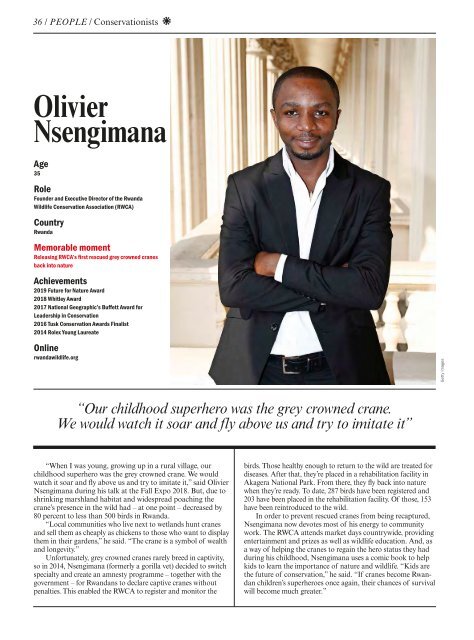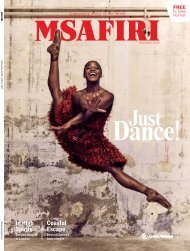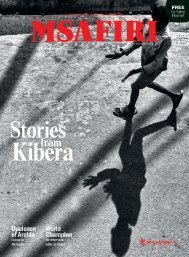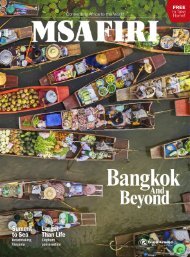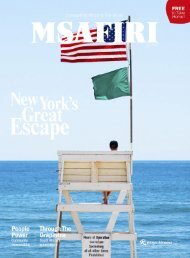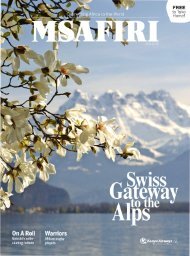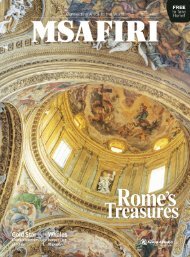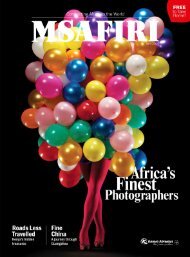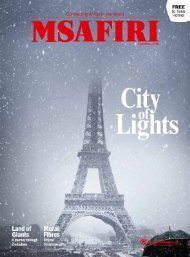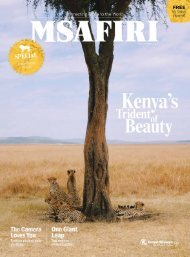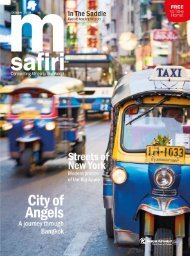You also want an ePaper? Increase the reach of your titles
YUMPU automatically turns print PDFs into web optimized ePapers that Google loves.
36 / PEOPLE / Conservationists<br />
PEOPLE / 37<br />
Olivier<br />
Nsengimana<br />
Emmanuel<br />
de Merode<br />
Age<br />
35<br />
Age<br />
49<br />
Role<br />
Founder and Executive Director of the Rwanda<br />
Wildlife Conservation Association (RWCA)<br />
Role<br />
Director and Chief Warden of the Virunga National<br />
Park<br />
Country<br />
Rwanda<br />
Country<br />
Democratic Republic of the Congo (DRC)<br />
Memorable moment<br />
Releasing RWCA’s first rescued grey crowned cranes<br />
back into nature<br />
Memorable moment<br />
Bringing electricity via hydropower to the<br />
communities around Virunga National Park<br />
Achievements<br />
<strong>2019</strong> Future for Nature Award<br />
2018 Whitley Award<br />
2017 National Geographic’s Buffett Award for<br />
Leadership in Conservation<br />
2016 Tusk Conservation Awards Finalist<br />
2014 Rolex Young Laureate<br />
Achievements<br />
2018 Freedom from Want award<br />
2015 Rolex National Geographic Explorer of the Year<br />
2015 Tusk Award for Conservation in Africa<br />
Online<br />
virunga.org<br />
Online<br />
rwandawildlife.org<br />
Getty images<br />
Getty images<br />
“Our childhood superhero was the grey crowned crane.<br />
We would watch it soar and fly above us and try to imitate it”<br />
“For me, it’s beyond doubt that without the Netflix film,<br />
the park would not exist today”<br />
“When I was young, growing up in a rural village, our<br />
childhood superhero was the grey crowned crane. We would<br />
watch it soar and fly above us and try to imitate it,” said Olivier<br />
Nsengimana during his talk at the Fall Expo 2018. But, due to<br />
shrinking marshland habitat and widespread poaching the<br />
crane’s presence in the wild had – at one point – decreased by<br />
80 percent to less than 500 birds in Rwanda.<br />
“Local communities who live next to wetlands hunt cranes<br />
and sell them as cheaply as chickens to those who want to display<br />
them in their gardens,” he said. “The crane is a symbol of wealth<br />
and longevity.”<br />
Unfortunately, grey crowned cranes rarely breed in captivity,<br />
so in 2014, Nsengimana (formerly a gorilla vet) decided to switch<br />
specialty and create an amnesty programme – together with the<br />
government – for Rwandans to declare captive cranes without<br />
penalties. This enabled the RWCA to register and monitor the<br />
birds. Those healthy enough to return to the wild are treated for<br />
diseases. After that, they’re placed in a rehabilitation facility in<br />
Akagera National Park. From there, they fly back into nature<br />
when they’re ready. To date, 287 birds have been registered and<br />
203 have been placed in the rehabilitation facility. Of those, 153<br />
have been reintroduced to the wild.<br />
In order to prevent rescued cranes from being recaptured,<br />
Nsengimana now devotes most of his energy to community<br />
work. The RWCA attends market days countrywide, providing<br />
entertainment and prizes as well as wildlife education. And, as<br />
a way of helping the cranes to regain the hero status they had<br />
during his childhood, Nsengimana uses a comic book to help<br />
kids to learn the importance of nature and wildlife. “Kids are<br />
the future of conservation,” he said. “If cranes become Rwandan<br />
children’s superheroes once again, their chances of survival<br />
will become much greater.”<br />
“When I was a teenager, I remember my parents telling<br />
me that gorillas were a species on the edge of extinction and I<br />
would never get to see them,” said Belgian Prince Emmanuel<br />
de Merode at the 2016 We Are Africa Conference. Instead,<br />
their survival has been “one of Virunga’s greatest conservation<br />
success stories”.<br />
The park’s gorilla population has increased from about 480<br />
individuals in 2010 to a minimum count of 604 individuals in<br />
2016. And now, in the flanks of thickly forested mountains,<br />
they’re the park’s main attraction.<br />
But this extraordinary place, which hosts the most diverse<br />
range of wildlife and varied terrain of any park, is located in an<br />
area of great conflict on the border of Rwanda, Uganda and<br />
DRC. “Illegal exploitation of resources, including a US$35<br />
million charcoal trade, has resulted in long-running conflict,<br />
which spills into the park,” added De Merode. He’s the only<br />
foreign national in the country bestowed with judicial powers,<br />
which have allowed him to open discussions with rebel forces<br />
and persuade them to stop shooting in the park.<br />
The complex struggle to preserve the park’s unique flora<br />
and fauna took a turn in 2012 when British oil company, Soco,<br />
began to explore for oil. The conflict that ensued was depicted<br />
in the award-winning Netflix documentary, Virunga, which<br />
ultimately contributed to Soco pulling out of the park.<br />
“For me, it’s beyond doubt that without the Netflix film,<br />
the park would not exist today,” said De Merode. “The film<br />
helped generate interest towards an ambitious programme<br />
encompassing hydro-electricity, schools and micro loans for<br />
the local population to better their quality of living. We have<br />
some four million of the poorest people living around here and<br />
they make the greatest sacrifice to have this area pristine for the<br />
overall betterment of mankind.”


